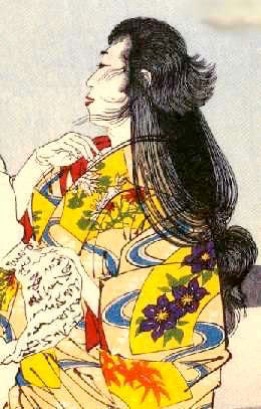Sei Shōnagon
Sei Shōnagon is almost as famous as Murasaki. The work she is remembered for is a collection of brilliant short essays known as The Pillow Book (Makura no Sōshi) in which she etched her mordant observations of people, life at court, and the aesthetics of nature. Perhaps seven or so years older than Murasaki, she was in service to Teishi, Emperor Ichijō’s first empress. Teishi was later displaced by Michinaga's daughter Shōshi—into whose salon Murasaki was eventually summoned. Thus Murasaki and Sei Shōnagon were members of rival literary salons. Murasaki was clearly aware of Shōnagon's writing, and may have seen drafts of The Pillow Book as early as 996 when she was in Echizen—although there is no proof that she in fact saw it then. Her opinion of her rival's character and writing was scathing. The description in my novel where Murasaki calls Shōnagon conceited, comes directly from her Diary.
Conventionally, the two writers have been contrasted to one another with Shōnagon as the witty conversationalist and Murasaki the reticent observer. I have built on this contrast in my characterizations as well. When Empress Teishi died, Shōnagon went into her sister Genshi's service, but it is not known what became of her after Genshi died a year later. There is no record of her and Murasaki ever meeting face to face. My chapter entitled "Sei Shōnagon" is an imagined "what if?" these two great writers had met and talked.
Japanese scholars have noticed imagery from The Pillow Book worked into The Tale of Genji. I have also pilfered from it. The largest chunk is the scene in my book describing how the emperor and empress (Teishi) were crazy about cats. The "Sei" in her name is the first character of her family name, Kiyowara, read in its Sino-Japanese pronunciation. No one is quite sure why she was called "Shōnagon," literally "lesser counselor," a court title. It was common for ladies in court service to go by such nicknames, often based on positions held by their fathers or husbands—although this lady does not seem to have had such a connection.
Ivan Morris, the esteemed translator of The Pillow Book, mentions research indicating that her given name may have been Nagiko.
